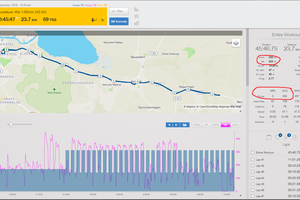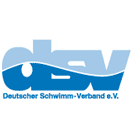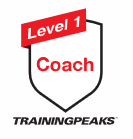Technical terms explained - Training Stress Score, normalized power and intensity factor

The starting point is to find the load of a training session and the training stimulus to the body of the athlete.
The fundamental goal by creating a training plan is to provide the athlete with the most effective training within his scope, not to overwhelm and underwhelm him. With help of the main value for the load of a training session, the so called training stress factor, translated from English "Training Stress Scores", abbreviated "TSS" and other values, the strain of training shall be, if necessary, approached cautiously and given necessary relaxation time to prepare the athlete perfectly for the race.
In the past, the average performance, speed and/or heart frequency were used relatively isolated for the load, today, additional values are used for an exact analysis. In addition to the achieved performance, the duration, load variation and fitness status of the athlete are of central importance.
With the original Trainings Stress Scores (TSS) designed by Dr. Andrew Coggan, designed for cycling, it is nowadays possible to attribute value to each training, based on a relative intensity and duration. In the past the inquiry of the load when cycling was determent with the performance and heart frequency. With today's progress in technology, the inquiry in all 3 sports can be determent with the heart frequency and speed.
Especially the trainings platform TrainingPeaks, developed from Joe Friel, sets milestones and is leading in the field of analysis of training data.
Here, the modern functional devices, that record all these values, save them during the training interval and transfer the data to the training platform, help, here values can be calculated and displayed graphically.
Since the result of the evaluation are theoretical and individual values, some experience is required to interpret and use these values in connection with other values.
Preconditions for exact analysis:
- Knowledge if the threshold power, speed or heart frequent of the respective sport.
- Long-term input and maintenance of the data in the system.
- In addition to the track duration and length, load patterns of single training sessions have to be present (the training file of a "pulse clock" or a bicycle computer contains all these values).
So far so good, how is now the training load (TSS) assembled?
The mathematic formula behind this seems complicated at first glance.
TSS = (sec x NP® x IF®)/(FTP x 3600) x 100
The single factors:
"sec" = Duration of the training session,
"NP" = Normalized Power® (explanation later),
"IF" = Intensity Factor® (Intensity of a training session, explanation later),
"FTP" = Anaerobic threshold (max. performance in one hour),
The terms briefly explained:
Normalized Power and intensity factor
 |
| Comparison of average power 204 watts (AVG Power) and NP 250 watts during a training session with intervals |
Normalized Power (NP),
With the normalized power the physiological stress to the body can be better expressed than with the average performance. The normalized power uses an algorithm, which describes the physiological stress better than the average performance.
While the average performance simply calculates the average of the wattage value achieved, variants such as sprints, incline or other load changes are also "assessed" when calculating the NP.
Intensity factor (IF)
Taking the example of a bicycle exit at the beginning of the season with normalized power (NP) of 180 watts and a threshold performance of 260 watts
IF= 220watt / 260 watt
IF=0,84
In the competition phase with the same NP but higher threshold performance indicates a lower overall stress to the body
IF= 220 Watt / 280 Watt:
IF=0,78
Since a theoretical max. intensity of 1 results from the formula, a higher IF-value (above 1 hour) is a clear indication that the FTP is higher as assumed and a performance development took place and/ or has to be retested.
Example:
A bicycle training session with steady pace is less stressful than a bicycle training session with many sprints and incline, even though both have the same average performance in the end.
Example in the picture.
Intensity Factor® (IF®)
This value should now help to describe the relative intensity of a session for a given period of time. The ratio of normalized power to the latest performance threshold.
IF = NP/FTP
Let us return to the TSS.
In the formula, we see that both NP and IF as factors have a direct influence on the training load (TSS).
TSS = (sec x NP® x IF®)/(FTP x 3600) x 100
This results in the following facts:
By definition, from the used values, a TSS of 100 results for one session at a performance limit/ anaerobic threshold for one hour.
The chart shows the attribution of the TSS values to specific training areas.
The following things can be deduced for the training:
TSS is smaller than 150: lower training load, the rest should be completed within 24h/ the next day
- TSS between 150 and 300: medium load – possibly fatigue the next day, but overcome on the second day
- TSS between 300 and 450: high load – possibly fatigue, a regeneration time of approximately 24h is necessary to be rested again
- TSS is higher as 450: very high load – likely fatigue for several days, the body needs time to process this training stimulus
In the Ironman competition, the sum of TSS values of the 3 disciplines a good age group athlete can be around 700. This results in corresponding rest values of several weeks.
Finally, is to say,
The TSS is of enormous importance for the periodization of the micro-, macro cycles of the training in connection with the fitness shape (Chronical Training Load-CTL) and the exhaustion (Acute Training Load-ALT).
The better the training sessions are populated, the more precise the trainer can predict the load on the athlete and thus plan the shape to the point.
I will write shortly about the two other values of fitness shape (Chronical Training Load-CTL) and exhaustion (Acute Training Load-ALT) in another article.
Normalized Power® (NP),Intensity Factor® (IF)
Training Stress Score® (TSS) are registered trademarks of TrainingPeaks Peaksware, LLC.












